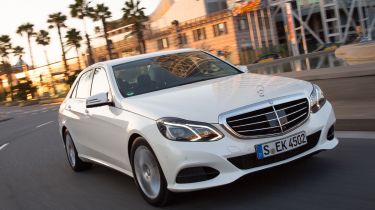Mercedes E250 CGI SE
Our verdict on the facelifted Mercedes E-Class, which gets a new look, new engine and hi-tech kit

The changes are so wide-ranging that you could get away with calling the E-Class a new car. The looks are a vast improvement and this fresh four-cylinder petrol engine is bound to make plenty of sense for company car buyers with its low CO2 emissions. It also feels marginally better to drive – even if the ride comfort did feel slightly worse on the roughest of roads – and the fact that it’s packed full of technology is a big bonus.
Some facelifts are more drastic than others, and the latest Mercedes E-Class updates can definitely be called dramatic. The new look means there’s certainly no mistaking it for the old E-Class, while under the skin there’s brand new safety technology and a couple of significant engine updates, too.
Most interesting of all is the new 2.0-litre four-cylinder petrol engine, which featured in the E250 we drove. It replaces the old 201bhp 1.8-litre engine and now has 208bhp, but with vastly improved economy thanks to direct injection and exhaust gas recirculation.
Fuel economy is improved from 42.8mpg to 48.7mpg, with CO2 emissions cut from 157g/km to 135g/km. That knocks company car tax down from 22 per cent to 18 per cent.
Used - available now

2022 Mercedes
E Class
46,558 milesAutomaticPetrol2.0L
Cash £26,763
2020 Mercedes
E Class
15,166 milesAutomaticPetrol2.0L
Cash £24,306
2022 Mercedes
E Class
44,201 milesAutomaticPetrol2.0L
Cash £25,900
2020 Mercedes
E Class
16,426 milesAutomaticDiesel2.0L
Cash £30,587But figures are only part of the story – this engine also impresses on the move. The full 350Nm of torque is available from 1,200 to 4,000rpm, so you can rest assured that whenever you floor the throttle, you’ll get a surge of acceleration. In fact, the official 0-62mph time of 7.4 seconds is three-tenths faster than the old E250’s.
The 7G-Tronic automatic gearbox feels much improved, too, with quicker upshifts and a near-immediate kickdown when you push hard on the accelerator. It’s still not quite as lightning-fast as the Audi or BMW automatic transmissions, though.
The engineers have made the new E-Class a little sharper to drive, too. On SE models the suspension is lowered by 15mm and the steering revised, making it more responsive just off-centre and a little heavier. As a result, the E-Class is more involving, but with a small penalty when it comes to smoothing bumps over very rough roads.
The new looks are what you’ll notice most, though, with the most obvious change to the headlights. The twin lamps of the old car are now merged into single-unit lights with a sharp LED design. A sportier grille featuring just two bars and a large Mercedes badge is now standard, although the traditional bonnet-mounted star and four-bar grille is still an option, as on the car in our pictures.
The rear lights and bumper have been subtly tweaked and the bulging ‘pontoon’ rear wheelarches have been ditched for a sharp horizontal crease just above the rear wheels.
Interior quality has improved, too – some of the black plastic buttons have been replaced with metal-effect ones, and there are new aluminium-look air-vent surrounds, while the instrument cluster now features three individually cowled dials.
A new version of Collision Prevention Assist is standard, and makes use of two cameras mounted just behind the rear-view mirror to help stop crashes with cars ahead or with crossing traffic. Buyers can now even opt for a self-parking system.






